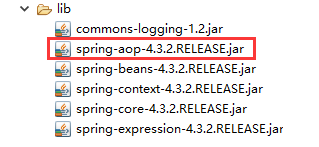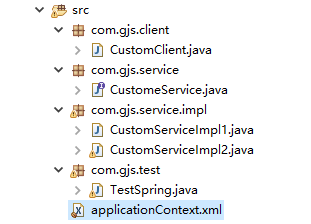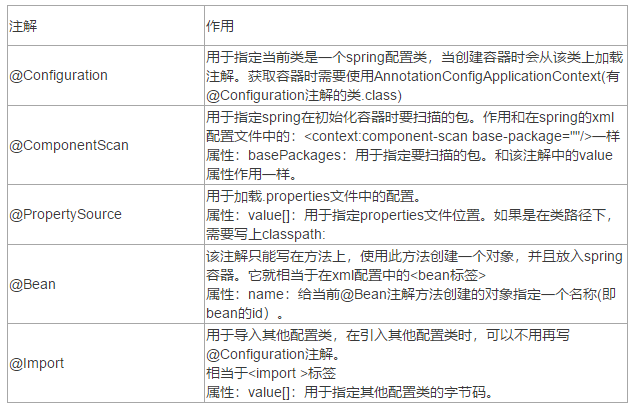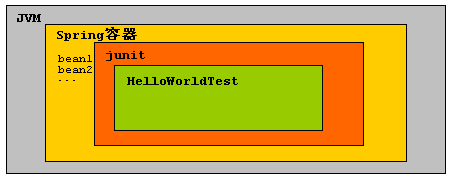1.为什么要学习Spring的注解配置?
基于注解配置的方式也已经逐渐代替xml。所以我们必须要掌握使用注解的方式配置Spring。
关于实际的开发中到底使用xml还是注解,每家公司有着不同的使用习惯。所以这两种配置方式都需要掌握。
学习基于注解的IoC配置,首先得有一个认知,即注解配置和xml配置要实现的功能都是一样的,都是要降低程序间的耦合。只是配置的形式不一样。
2.入门示例
步骤:
1.导入jar包,相对于之前的,在基于注解的配置中,我们还要多拷贝一个aop的jar包。

2.在classpath下创建一个配置文件applicationContext.xml,并导入约束,基于注解整合时,配置文件导入约束时需要多导入一个context名称空间下的约束
<?xml version="1.0" encoding="UTF-8"?> <beans xmlns="http://www.springframework.org/schema/beans" xmlns:p="http://www.springframework.org/schema/p" xmlns:context="http://www.springframework.org/schema/context" xmlns:xsi="http://www.w3.org/2001/XMLSchema-instance" xsi:schemaLocation="http://www.springframework.org/schema/beans http://www.springframework.org/schema/beans/spring-beans.xsd http://www.springframework.org/schema/context http://www.springframework.org/schema/context/spring-context.xsd "> </beans>
3.创建一个用于测试的类,并且加入使用@Component注解,声明该类允许注入到Spring容器
import org.springframework.stereotype.Component; /* * @Component 组件注解,spring在启动的时候扫描对应的包下面的所有类型 * 如果哪一个类上只要有 @Component 注解,说明这个就需要被Spring管理 * Spring在容器就创建这个类的对象 * * @Component 属性介绍 * @Component(value="id值") * value :指定 bean 的 id值 * 可以不写,默认bean的id就是当前类名的 首字母小写 * 如果写,“value=”可以省略,直接"id值" * */ @Component("service") public class Service { public void say() { System.out.println("你好!Spring"); } }
4.往配置文件加入扫描组件配置
<?xml version="1.0" encoding="UTF-8"?> <beans xmlns="http://www.springframework.org/schema/beans" xmlns:p="http://www.springframework.org/schema/p" xmlns:context="http://www.springframework.org/schema/context" xmlns:xsi="http://www.w3.org/2001/XMLSchema-instance" xsi:schemaLocation="http://www.springframework.org/schema/beans http://www.springframework.org/schema/beans/spring-beans.xsd http://www.springframework.org/schema/context http://www.springframework.org/schema/context/spring-context.xsd "> <!-- 配置spring要进行扫描的组件注解的包(默认包含子包)的位置 --> <context:component-scan base-package="com.gjs.service"/> </beans>
5.测试代码
import org.junit.Test; import org.springframework.context.ApplicationContext; import org.springframework.context.support.ClassPathXmlApplicationContext; import com.gjs.service.Service; public class TestSpring { @Test public void testName() throws Exception { ApplicationContext context = new ClassPathXmlApplicationContext("applicationContext.xml"); Service service = context.getBean("service",Service.class); service.say(); } }
3.常用注解说明
3.1 IOC相关注解
用于被扫描创建对象的注解,统称为组件注解。组件包括:@Component,@Controller,@Service,@Repository。它们的作用是标识类为注解的组件类,启动Spring框架的程序时,声明将这些组件类注入到Spring容器里面。功能类似原来配置文件的<bean>标签。
其他它们的功能是一样的并没有本质上的区别,哪为什么会有4个呢?
Spring第一版注解的实现(spring 2.5),就是使用一个@Component。从3.0以后,作者认为根据分层的需要,把它拆成了四个。为了可以让开发人员,可见即可得,一看到注解,立即知道类的性质。所以分成了四个。
规范:
@Controller:用于声明表示层的组件注解
@Service:用于声明服务层的组件注解
@Repository:用于声明持久层的组件注解
@Component:用于声明三层以外的组件注解
除了@Controller在SpringMVC里面有强制的要求,SpringMVC的表示层必须使用@Controller组件注解。其他情况不按规范使用也不会有问题,但既然是规范就要遵守。
@Scope:指定作用范围,等同于Xml配置<bean>标签中的scope
@Component("service")
@Scope("prototype")
public class Service {
public void say() {
System.out.println("你好!Spring");
}
}
@PostConstruct:初始化方法注解,等同于Xml配置<bean>标签中的init-method
@PostConstruct public void init() { System.out.println("初始化方法执行了"); }
@PreDestroy:销毁方法注解,等同于Xml配置<bean>标签中的destroy-method
@PreDestroy public void destroy() { System.out.println("销毁方法执行了"); }
3.2 依赖注入的注解
Spring提供了两套用注解依赖注入的解决方案
1.@Autowired +@Qualifier():是Spring定义的标签
2.@Resouce:是J2EE的规范
@Autowired +@Qualifier()
@Autowired +@Qualifier()有三种注入的方式:
1.在字段上面注入
2.在方法上面注入
3.在构造方法上面注入
示例:
整体结构:

CustomeService接口:
package com.gjs.service; public interface CustomeService { public void say(); }
CustomServiceImpl1:
package com.gjs.service.impl; import org.springframework.stereotype.Service; import com.gjs.service.CustomeService; @Service("service1") public class CustomServiceImpl1 implements CustomeService { @Override public void say() { System.out.println("CustomerServiceImpl1.say()"); } }
CustomServiceImpl2:
package com.gjs.service.impl; import org.springframework.stereotype.Service; import com.gjs.service.CustomeService; @Service("service2") public class CustomServiceImpl2 implements CustomeService { @Override public void say() { System.out.println("CustomerServiceImpl2.say()"); } }
CustomController:
package com.gjs.client; import org.springframework.beans.factory.annotation.Autowired; import org.springframework.beans.factory.annotation.Qualifier; import org.springframework.stereotype.Controller; import com.gjs.service.CustomeService; @Controller("client") public class CustomController { /* * 方式一(推荐) : 在字段(成员变量)上注入 * @Autowired : * 默认会从Spring容器找对应类型的对象注入进来 * 使用@Autowired 必须保证Spring容器中最少一个类型对应bean ,如果没有就会抛异常 * org.springframework.beans.factory.NoSuchBeanDefinitionException * 可以使用 注解的 required属性(除特殊情况,一般不使用) * required = true/false 是否是必须有对应的对象,true 是必须有(默认),false 不是必须有 * * 如果spring容器有多个相同类型的对象,默认无法注入也会抛异常 * org.springframework.beans.factory.NoUniqueBeanDefinitionException 不是唯一的bean异常 * 这时就需要配合使用 @Qualifier() 注解了 * @Qualifier(value="对应bean的id值")可以在多个相同类型的对象中筛选指定唯一id的对象,“value=”可以省略 */ //@Autowired(required=false) //@Qualifier("service1") private CustomeService customeService; /* * 方式二 :使用setter方法(属性)注入 * 将@Autowired直接贴在set方法上面即可,程序运行,会执行set方法 * 将Spring容器对应的类型的参数赋值给 set方法的参数,类型不存在或存在多个,处理方式与方式一一样 */ //@Autowired() //@Qualifier("service1") public void setCustomeService(CustomeService customeService) { this.customeService = customeService; } /* * 方式三 : 构造器注入 * 使用注解的IOC创建bean的情况下 * 默认bean中有什么样的构造器,spring就调用那个构造器去创建对应的bean对象 * 并且会自动注入 构造器中对应类型参数的对象,无须@Autowired() * * 如果构造函数的参数类型对应的bean有多个就在 在参数前面 使用 @Qualifier()注解,指定 对应的bean的id */ public CustomController(@Qualifier("service1")CustomeService customeService) { this.customeService = customeService; } public void say() { customeService.say(); } }
applicationContext.xml:
<?xml version="1.0" encoding="UTF-8"?> <beans xmlns="http://www.springframework.org/schema/beans" xmlns:p="http://www.springframework.org/schema/p" xmlns:context="http://www.springframework.org/schema/context" xmlns:xsi="http://www.w3.org/2001/XMLSchema-instance" xsi:schemaLocation="http://www.springframework.org/schema/beans http://www.springframework.org/schema/beans/spring-beans.xsd http://www.springframework.org/schema/context http://www.springframework.org/schema/context/spring-context.xsd "> <!-- 配置spring要进行扫描的组件注解的包(默认包含子包)的位置 --> <context:component-scan base-package="com.gjs"/> </beans>
测试类TestSpring:
package com.gjs.test; import org.junit.Test; import org.springframework.context.ApplicationContext; import org.springframework.context.support.ClassPathXmlApplicationContext; import com.gjs.client.CustomController; public class TestSpring { @Test public void testName() throws Exception { //1.读取配置文件,创建Spring容器 ApplicationContext context = new ClassPathXmlApplicationContext("applicationContext.xml"); //获取调用方 CustomClient对象 CustomController client = context.getBean("client", CustomController.class); //调用CustomClient对象的say()方法 client.say(); } }
@Resouce
@Resource 功能等同 @Autowired + @Qualifier
@Resource只能注入字段和setter方法,不能注入构造方法
CustomController类,其他参考上面的
package com.gjs.client; import javax.annotation.Resource; import org.springframework.beans.factory.annotation.Autowired; import org.springframework.beans.factory.annotation.Qualifier; import org.springframework.stereotype.Controller; import com.gjs.service.CustomeService; @Controller("client") public class CustomController { /* * 方式一: 字段注入 * 也是默认会从Spring容器找对应类型的对象注入进来 * 有多个相同类型时,可以使用@Resource(name="对应bean的id")指定注入哪个对象 * @Resource 必须保证需要注入的类型在Spring容器中最少有一个对象,没有直接抛异常 */ //@Resource(name="service1") private CustomeService customeService; /* * 方式二: set方法(属性)注入 */ @Resource(name="service1") public void setCustomeService(CustomeService customeService) { this.customeService = customeService; } public void say() { customeService.say(); } }
@Value注解
@Value注解:注入基本数据类型以及它们的包装类和String类型数据的,支持${}注入Properties文件的键值对,等同 <proprty name=”...” value=”${Key}”>。
@Repository public class UserDaoImpl implements UserDao { /** * @Value(value="") * 可以从Spring容器读取 .properties 配置文件内容 * value :配置文件的对应的key -->使用 ${key} 获取 * 程序运行中自动将 properties 对应key的获取出来设置给字段 * */ //等价 <property name="driverClassName" value="${jdbc.driverClassName}"> @Value("${jdbc.driverClassName}") private String driverClassName; @Value("${jdbc.url}") private String url; @Value("${jdbc.username}") private String username; @Value("${jdbc.password}") private String password; //@Value("${jdbc.maxActive}") @Value("10") //开发者也手动赋值 private String maxActive; @Override public void insert(User user) { System.out.println(driverClassName); System.out.println(url); System.out.println(username); System.out.println(password); System.out.println(maxActive); } }
4.纯注解配置
虽然使用注解的方式,但我们还是离不开xml文件,因为我们还有配置组件扫描位置,如果这也能用注解配置,那么我们就可以脱离xml文件了。
替换XML配置文件的注解:

package com.gjs.config; import javax.sql.DataSource; import org.springframework.beans.factory.annotation.Value; import org.springframework.context.annotation.Bean; import org.springframework.context.annotation.ComponentScan; import org.springframework.context.annotation.Configuration; import org.springframework.context.annotation.PropertySource; import com.alibaba.druid.pool.DruidDataSource; /* * @Configuration * 说明把当前类当做成Spring框架的配置文件 * @ComponentScan * 配置注解包扫描的位置 * @PropertySource("classpath:db.properties") * 读取.peroperties 后缀的配置文件 */ @Configuration @ComponentScan("com.gjs") @PropertySource("classpath:db.properties") public class SpringConfig { /** * @Value(value="") * 可以从Spring容器读取 .properties 配置文件内容 * value :配置文件的对应的key -->使用 ${key} 获取 * 程序运行中自动将 properties 对应key的获取出来设置给字段 * */ //等价 <property name="driverClassName" value="${jdbc.driverClassName}"> @Value("${jdbc.driverClassName}") private String driverClassName; @Value("${jdbc.url}") private String url; @Value("${jdbc.username}") private String username; @Value("${jdbc.password}") private String password; @Value("${jdbc.maxActive}") private Integer maxActive; //<bean id="dataSource" class="com.alibaba.druid.pool.DruidDataSource" //init-method="init" destroy-method="close"> @Bean(name="dataSource",initMethod="init",destroyMethod="close") public DataSource getDataSource() { DruidDataSource dataSource = new DruidDataSource(); dataSource.setDriverClassName(driverClassName); dataSource.setUrl(url); dataSource.setUsername(username); dataSource.setPassword(password); dataSource.setMaxActive(maxActive); return dataSource; } }
5. Spring的测试
5.1.传统的单元测试
存在的问题:
1,每个测试都要重新启动Spring容器,启动容器的开销大,测试效率低下。
2,不应该是测试代码管理Spring容器,应该是Spring容器在管理测试代码。

5.2 正确的Spring的测试

5.3 如何使用Spring测试
Spring测试必须保证Eclipse的单元测试的最低版本是 4.12版本,如果使用的Eclipse版本很低,那么单元测试版本可能低于4.12,那么需要开发者手动导入单元测试的jar包
要使用Spring测试就要先导入test的jar包

package com.gjs.test; import org.junit.Test; import org.junit.runner.RunWith; import org.springframework.context.ApplicationContext; import org.springframework.context.support.ClassPathXmlApplicationContext; import org.springframework.test.context.ContextConfiguration; import org.springframework.test.context.junit4.SpringJUnit4ClassRunner; import com.gjs.client.CustomController; //表示先启动Spring容器,把junit运行在Spring容器中 @RunWith(SpringJUnit4ClassRunner.class) //表示从哪里加载资源文件,默认从src(源目录)下面加载 @ContextConfiguration("classpath:applicationContext.xml") public class TestSpring { @Test public void testName() throws Exception { //1.读取配置文件,创建Spring容器 ApplicationContext context = new ClassPathXmlApplicationContext("applicationContext.xml"); //获取调用方 CustomClient对象 CustomController client = context.getBean("client", CustomController.class); //调用CustomClient对象的say()方法 client.say(); } }